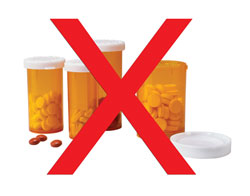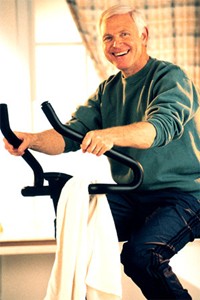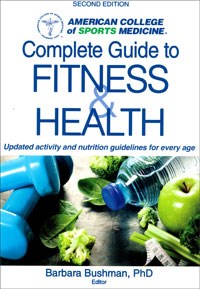|
Exercise For Depression
Author:
Stan Reents, PharmD
Original Posting:
05/06/2007 06:59 AM
Last Revision: 08/22/2019 02:41 PM
 According to the National Institute of Mental Health (www.NIMH.NIH.gov, accessed March 17, 2018), 16 million adults and 3 million adolescents (ages 12-17) in the US had at least one major depressive episode in 2016: According to the National Institute of Mental Health (www.NIMH.NIH.gov, accessed March 17, 2018), 16 million adults and 3 million adolescents (ages 12-17) in the US had at least one major depressive episode in 2016:
Adults: 16.2 million
- males: 4.8%
- females: 8.5%
Adolescents (12-17 yrs): 3.1 million
Note the disturbingly high rate in teenage girls.
And now, there's a new concern: too much time spent on social media. The impact of this on mental health is only starting to be explored, but, reports are coming out that adolescents have higher rates of stress, anxiety, and depression than in past decades.
But, while the focus is currently on smart-phone usage, texting, and time spent on social media, there is another obvious factor that is being overlooked: lack of exercise. Certainly, when you're using your mobile device, you're not exercising!
Stats from the 2017 National Health Interview Survey were released in March 2018: The percentage of young adults who meet the federal aerobic activity guidelines ranges about 55-65%, depending on age group. That's not bad, but it could be a lot better.
EXERCISE IS AN EFFECTIVE TREATMENT FOR DEPRESSION
It's not uncommon to hear people talk about a "runner's high", or, that they exercise because it makes them "feel good." And research shows that regular physical activity can prevent depression (Mammen G, et al. 2013).
But, can exercise actually be "therapeutic" in people who are already depressed?
It turns out that plenty of evidence shows that exercise can be beneficial in patients who are depressed. In fact, the effects of exercise on depression have been studied for 3 decades:
In 1994, exercise researcher Ralph Paffenbarger, MD, and colleagues, found that depression rates were lower in physically-active Harvard alumni (Paffenbarger RS, et al. 1994). Since then, exercise has been shown to be beneficial for depression in college students (Kim KB, et al. 2004), in adults ages 20-45 years (Dunn AL, et al. 2005), in the elderly (Palmer C. 2005), and in post-partum mothers (Wilkinson J, et al. 2003).
Exercise for Depression in Patients with Specific Diseases
Exercise is also beneficial when patients with chronic disease become depressed, even in conditions that severely limit exercise capacity:
• Cardiac Patients: In one study of 338 patients undergoing cardiac rehab after a major cardiac event, 20% reported depressive symptoms. After 3 months of aerobic exercise, two-thirds of these depressed patients had improvement (Milani RV, et al. 1996).
• Patients with COPD: Several studies have shown that an exercise program can increase not only exercise capacity in patients with COPD, but that symptoms of anxiety and depression also improve (Emery CF, et al. 1991) (Emery CF, et al. 1998) (Withers NJ et al. 1999). One study utilized a "pulmonary rehabilitation" program that included: 30-minute stretching and breathing classes, 40-minute exercise classes, treadmill and upper-extremity training, leisure walking, and recreational activities. After 24 weeks, patients showed increases in exercise capacity and ratings of emotional function (Goldstein RS, et al. 1994).
• Patients with Arthritis: Depression in patients with rheumatoid or osteoarthritis improved after a 12-week program of either aerobic walking or aerobic water exercise (Minor MA, et al. 1989). In another study, patients with ankylosing spondylitis who performed 20 minutes of exercise daily for 8 consecutive weeks showed improvements in depression scores (Lim HJ, et al. 2005).
• Patients receiving Hemodialysis: Fourteen hemodialysis patients were enrolled in a program consisting of exercise on a bicycle ergometer, a treadmill, or an upper limb ergometer 60 minutes per session, 3 times per week, for 12 weeks. Both anxiety and depression improved (Suh MR, et al. 2002).
• Patients with Alzheimer's disease: A home-based exercise program improved depression in patients with Alzheimer's disease. The program was 30 minutes per day of moderate-intensity exercise consisting of a mixture of aerobic exercise, strength exercise, balance exercise, and flexibility training (Teri L, et al. 2003).
• Diseases caused by chronic, low-level inflammation: It is now accepted that many years of low-level inflammation contributes to a wide variety of chronic diseases. This inflammation is not like the severe joint-destroying situation seen in rheumatoid arthritis. Rather, it's much more subtle; it doesn't cause noticeable symptoms. Generally, it is identified by measuring blood levels of molecules such as C-reactive protein (C-RP), interleukin-6 (IL-6), and others. It's been shown that depressed patients have higher levels of C-RP (Cepeda MS, et al. 2016). And, people who exercise have lower levels of C-RP (Hamer M, et al. 2012). Thus, this suggests that exercise may be helpful for depression in other disease states.
NO IT ISN'T...
But, not all of the medical research on exercise for depression is positive:
A "meta-analysis" is a secondary analysis of many studies that have been published on a particular topic. Debbie Lawlor, PhD, MBChB, MPH, a professor at the University of Bristol in the UK, and colleagues, have reviewed the research on exercise for depression via a meta-analysis no fewer than 6 times (Cooney GM, et al. 2013) (Lawlor DA, et al. 2001) (Krough J, et al. 2011) (Mead GE, et al. 2008) (Mead GE, et al. 2009) (Rimer J, et al. 2012). In these assessments -- each time including newer studies -- they have come to the conclusion that, while exercise is modestly effective, the design of the research studies compromises certainty.
This finding is somewhat understandable. Think for a minute how subjective depression is. After all, it's not like measuring blood pressure with an arm cuff, or, drawing blood to measure glucose and cholesterol.
However, it appears that how these research studies are designed and evaluated may be the reason why different reports offer different conclusions. Researchers from Brazil analyzed some of the same studies and concluded that moderate intensity aerobic exercise had a "large and significant benefit on depression" (Schuch FB, et al. 2016).
One major study appears to be highly misleading: the TREAD-UK study. This report was published in the prestigious British Medical Journal on June 6, 2012. It evaluated 361 adults, ages 18-69. These patients were coached to exercise regularly: first, in 3 face-to-face encounters, then via telephone. Evaluations were made at 4 months, 8 months, and at 12 months.
The researchers found that, after 12 months, exercise was no more effective than usual care for depression, and it did not lead to a reduction in the use of anti-depressant drugs (Chalder M, et al. 2012).
Subsequently, on January 19, 2018, members of the Department of Kinesiology at Iowa State University published a detailed critique of this research. They state that the design of the TREAD-UK study was flawed. They go on to point out how widely-publicized the TREAD-UK study was, and, how this report misled clinicians (Ekkekakis P, et al. 2018).
Bottom line? Yes, exercise can be very effective for managing depression. Keep reading...
(AEROBIC) EXERCISE IS AS EFFECTIVE AS ANTI-DEPRESSANT DRUGS
Surprisingly, antidepressant drugs are not very effective: 30-40% of patients do not respond adequately to first-line antidepressant therapy (Brosse AL, et al. 2002).
You may also be surprised to learn that head-to-head comparisons of exercise vs. drug therapy in the management of specific disease states are scant.
One of the reasons is that the FDA does not require this to be evaluated during Phase III clinical trials of a new drug being investigated. As a result, Big Pharma has no incentive to conduct drug vs. exercise studies.
Aerobic Exercise vs. Sertraline
In some scenarios though, academic researchers do explore this very important concept. James Blumenthal, PhD, at Duke University, and colleagues, have conducted several studies comparing aerobic exercise to the antidepressant sertraline (marketed as Zoloft® by Pfizer) in the management of depression:
One of their first studies was published in 1999. Older patients with major depression were randomized to 1 of 3 groups: an aerobic exercise program, the anti-depressant drug sertraline, or both. Using 2 different depression scoring assessments, the exercise program was just as effective as sertraline (average sertraline dose was 100 mg/day). The group that received both treatments improved by the same amount as the other 2 groups.
WHAT TYPE OF EXERCISE IS BEST?
OK, so, exercise is effective enough that it can be a first-line treatment in the management of patients with depression. And because the response to anti-depressant drugs is unreliable, maybe exercise is worth considering. But, what type of exercise, and, how much?
Type of Exercise
There are several types of exercise to consider:
- aerobic exercise
- resistance (strength) exercise
- "stress-reducing" exercise (eg., Tai Chi, yoga)
- "green" exercise
• Aerobic Exercise: Most of the research on the effectiveness of exercise for treating depression has evaluated some form of aerobic exercise: running, biking, aerobic walking, etc. In the studies conducted by James Blumenthal, PhD, at Duke, the exercise program consisted of 3 sessions per week for 16 weeks. Each session lasted 45-minutes: 10-min of warm-up, 30-min of aerobic exercise (walking and jogging at an intensity to maintain exercise heart rate at 70-85% of heart-rate-reserve), followed by 5-min of cool down exercises (Blumenthal JA, et al. 1999).
• Resistance (Strength) Exercise: Much less research exists for resistance exercise (for managing depression) than for aerobic exercise. One study of cardiac patients showed that the addition of strength training to a cardiac rehab program provided improvement in depression (Beniamini Y, et al. 1997). An Australian study (see below) revealed that a progressive, high-intensity resistance-training program improved depression in 61% of older adults (Singh NA, et al. 2005).
• Tai Chi, Yoga: Helen Lavretsky, MD, at UCLA, and colleagues, have conducted several studies showing that Tai Chi or yoga can improve depression (Lavretsky H, et al. 2011) (Siddarth D, et al, 2014).

• "Green" Exercise: You may not have heard of "green" exercise. This term has been used to describe outdoor exercise...ie., interacting with nature. It was coined in 2003 by Jules Pretty, PhD, and Jo Barton, PhD, at the University of Essex in the UK (see: www.GreenExercise.org). It turns out that exercising outdoors -- in natural places -- really does have positive effects on your mood. Dr. Barton and Dr. Pretty have published dozens of studies on this. They have shown that exercising in "green spaces" has a positive effect on mood regardless if that space is in an urban setting, or, in the wilderness (Barton J, et al. 2010). Researchers in South Korea had college students walk once per week in an on-campus forest (and one additional walking session per week) and found a significant improvement in depression (Bang KS, et al. 2017). The effect of exercising in nature is even more pronounced if near a body of water (Barton J, et al. 2010).
The potential benefits that exercising in nature has on depression are so significant that the term "forest therapy" has evolved (Lee I, et al. 2017).
But, does the benefit come from the exercise, or just being out in nature? Research shows that exercising outdoors in natural places really is more beneficial for your mood than exercising indoors (Thompson-Coon J, et al. 2011).
Is Exercise or Social Interaction the Explanation?
It's also possible that group exercise is beneficial for depressed patients simply due to the social interaction it provides...ie., as opposed to the physical effects of exercise. When studying populations of people around the world that live to 100, the Blue Zones researchers discovered that social interaction was a common behavior. Social interaction contributes to happiness, and, in turn, happy people live longer. They felt that social interaction was so significant, it became 1 of their 9 core principles. That is why the Cooper Institute study summarized below specifically excluded group exercise. They found that exercise without any social interaction (ie., on a treadmill or exercise bike) was beneficial for depression.
Dr. Barton and Dr. Pretty have also looked at the impact of social interaction. In one of their studies, they compared a weekly session of green exercise to a weekly session of either group health promotion or participation in a group swimming club. The improvements in self-esteem were substantially greater in those who participated in weekly green exercise (Barton J, et al. 2012).
Thus, exercise does improve mood independently of any effects that social interaction provides.
Amount of Exercise
In general, to maintain mental health, researchers have found that 2.5 - 7.5 hours of physical activity per week is optimum (Kim YS, et al. 2012). (Though, it doesn't take that much time if exercising outdoors in natural spaces!....see below.)
• Aerobic Exercise: Aerobic exercise can be assessed by using the "FITT" acronym: frequency, intensity, type, time.
Researchers at the Cooper Institute in Dallas have attempted to figure out how much and how "hard" exercise should be to provide benefit for depression (Dunn AL, et al. 2002) (Dunn AL, et al. 2005):

Since prior research showed that various levels of exercise intensity improve symptoms of depression, the Cooper Institute investigators let their subjects exercise at their own intensity. Instead, they focused on AMOUNT and FREQUENCY.
Eighty people were randomly placed into 1 of 5 groups. Two of the 5 groups participated in treadmill running or riding a stationary bicycle: one group exercised 3 days per week, the other group exercised 5 days per week. Two more groups also exercised either 3 or 5 days per week, but performed less exercise per week. The fifth group did not do any aerobic exercise, but participated only in stretching and flexibility exercises 3 days per week.
After 12 weeks, the 2 groups who performed a higher amount of weekly exercise had a 47% decrease in depressive symptoms; it didn't matter whether they exercised 3 or 5 days per week. The 2 groups who were in the lower amount of weekly exercise showed a 30% decline in symptoms, while the stretching-flexibility exercise group showed a 29% decline (Dunn AL, et al. 2005).
So how much exercise did the "higher amount" group actually do?
The "higher amount" exercise group burned up 17.5 kcal/kg per week; this was divided into either 3 sessions, or 5 sessions. To put these numbers into a more practical discussion, a 70-kg person would have exercised (moderately) for 180 minutes during the week. If that exercise was divided into 3 sessions, then they would have walked or jogged about 3-4 miles per session.
The "lower amount" group burned up 7 kcal/kg per week. A 70-kg person would have exercised (moderately) only about 80 minutes total for the week.
This study from the Cooper Institute is one of the only studies attempting to determine the proper "dose" of aerobic exercise that is "therapeutic" for depressed patients. They concluded that AMOUNT, but not INTENSITY or FREQUENCY, is the most important variable.
• Resistance (Strength) Exercise: The Australian study mentioned above revealed that high-intensity weight-training (80% maximum load) was substantially more effective for depression than was low-intensity weight-training (20% maximum load). Both groups trained 3 times per week for 8 weeks. A positive response was seen in 61% of the high-intensity group compared to only 29% of the low-intensity group (Singh NA, et al. 2005).
• Tai Chi, Yoga: In the UCLA studies by Dr. Lavretsky, subjects participated in Tai Chi or yoga for 120 minutes per week. In one study, the Tai Chi class was 120 minutes, once per week. This included 10 minutes of warm-up (stretching and breathing) and 5 minutes of cool-down (Lavretsky H, et al. 2011). In the other, the Tai Chi and yoga classes were 60-min sessions, twice per week (Siddarth D, et al. 2014).
• "Green" Exercise: Dr. Barton and Dr. Pretty evaluated how much green exercise is necessary to produce a positive effect on mood. The answer? It only takes a few minutes of exercising in natural spaces! (Barton J, et al. 2010).
"STEPS" YOU SHOULD TAKE
In general, many different types of exercise have been shown to be effective for depression:
Most of the research on using exercise to treat depression has focused on aerobic forms of exercise. The current "official" exercise guidelines recommend that adults obtain 30 minutes of moderate-intensity exercise on most, if not all, days of the week. That adds up to at least 150 minutes each week. Brisk walking is a good example of moderate-intensity exercise, so, start with that. However, it appears that it only takes several minutes of exercising outdoors in natural spaces to improve mood. In general, "green" exercise is more effective than indoor exercise.
For weight-training, it appears that a more intensive program is more effective than a light-intensity program.
I'm a big fan of outdoor exercise, and especially in natural places as opposed to right next to a busy road. Hiking is a great activity because if the trail is hilly, you actually get 4 different types of exercise: aerobic exercise, strength exercise (for your legs), balance exercise, and, "green" exercise. And if you do it with others, you get the additional psychological benefits of social interaction!
SUMMARY
Research from the past 2 decades offers strong evidence that moderate exercise can be beneficial in the management of depression. Despite this, few psychotherapists promote exercise. Clinicians also caution that exercise should not be the sole basis of treatment for depression.
We'll leave it up to the scientists to debate what type of exercise works best. From our perspective, ANY exercise is better than none.
So, put away that smart phone or electronic device and go for a hike in the woods!
FOR MORE INFORMATION
The 2nd edition (2017) of the American College of Sports Medicine's "Complete Guide to Fitness & Health" contains a chapter on Exercise For Depression.
Readers may also be interested in:
EXPERT HEALTH and FITNESS COACHING
Stan Reents, PharmD, is available to speak on this and many other exercise-related topics. (Here is a downloadable recording of one of his Health Talks.) He also provides a one-on-one Health Coaching Service. Contact him through the Contact Us page.
REFERENCES
Bang KS, Lee I, Kim S, et al. The effects of a campus forest-walking program on undergraduate and graduate students' physical and psychological health. Int J Environ Res Public Health 2017; 14(7): pii E728. Abstract
Barton J, Griffin M, Pretty J. Exercise-, nature-, and socially interactive-based initiatives improve mood and self-esteem in the clinical population. Perspect Public Health 2012;132:89-96. Abstract
Barton J, Pretty J. What is the best dose of nature and green exercise for improving mental health? A multi-study analysis. Environ Sci Technol 2010;44:3947-3955. Abstract
Beniamini Y, Rubenstein JJ, Zaichkowsky LD, et al. Effect of high-intensity strength training on quality-of-life parameters in cardiac rehabilitation patients. Am J Cardiol 1997;80:841-846. Abstract
Berman MG, Jonides J, Kaplan S. The cognitive benefits of interacting with nature. Psychol Sci 2008;19:1207-1212. Abstract
Blumenthal JA, Babyak MA, Moore KA, et al. Effects of exercise training on older patients with major depression. Arch Intern Med 1999;159:2349-2359. Abstract
Brosse AL, Sheets ES, Lett HS, et al. Exercise and the treatment of clinical depression in adults. Sports Med 2002;32:741-760. Abstract
Cepeda MS, Stang P, Makadia R. Depression is associated with high levels of C-reactive protein and low levels of fractional exhaled nitric oxide. J Clin Psychiatry 2016;77:1666-1671. Abstract
Chalder M, Wiles NJ, Campbell J, et al. Facilitated physical activity as a treatment for depressed adults: randomised controlled trial. Br Med J 2012;344:e2758. Abstract
Cooney GM, Dwan K, Greig CA, et al. Exercise for depression - 2013. Cochrane Database Syst Rev 2013 Sept 12;(9):CD004366. Abstract
Dunn AL, Trivedi MH, Kampert JB, et al. The DOSE study: a clinical trial to examine efficacy and dose response of exercise as treatment for depression. Control Clin Trials 2002;23:584-603. Abstract
Dunn AL, Trivedi MH, Kampert JB, et al. Exercise treatment for depression: efficacy and dose response. Am J Prev Med 2005;28:1-8. Abstract
Ekkekakis P, Hartman ME, Ladwig MA. Mass media representations of the evidence as a possible deterrent to recommending exercise for the treatment of depression: lessons five years after the extraordinary case of TREAD-UK. J Sports Sciences 2018;1-12. Abstract
Emery CF, Leatherman NE, Burker EJ, et al. Psychological outcomes of a pulmonary rehabilitation program. Chest 1991;100:613-617. Abstract
Emery CF, Schein RL, Hauck ER, et al. Psychological and cognitive outcomes of a randomized trial of exercise among patients with chronic obstructive pulmonary disease. Health Psychol 1998;17:232-240. Abstract
Goldstein RS, Gort EH, Stubbing D, et al. Randomised controlled trial of respiratory rehabilitation. Lancet 1994;344:1394-1397. Abstract
Hamer M, Sabia S, Batty GD, et al. Physical activity and inflammatory markers over 10 years. Follow-up in men and women from the Whitehall II Cohort Study. Circulation 2012;126:928-933. Abstract
Katon W, Sullivan MD. Depression and chronic medical illness. J Clin Psychiatry 1990;51:3-14. Abstract
Kessler RC, McGonagle KA, Zhao S, et al. Lifetime and 12-month prevalence of DSM-III-R psychiatric disorders in the United States. Arch Gen Psychiatry 1994;51:8-19. Abstract
Kim KB, Cohen SM, Oh HK, et al. The effects of meridian exercise on anxiety, depression, and self-esteem of female college students in Korea. Holist Nurs Pract 2004;18:230-234. Abstract
Kim YS, Park YS, Allegrante JP, et al. Relationship between physical activity and general mental health. Prev Med 2012;55:458-463. Abstract
Lavretsky H, Altstein L, Olmstead RE, et al. Complementary use of Tai Chi Chih augments escitalopram treatment of geriatric depression. A randomized controlled trial. Am J Geriatr Psychiatry 2011;19:839-850. Abstract
Lee I, Choi H, Bang KS, et al. Effects of forest therapy on depressive symptoms among adults: A systematic review. Int J Environ Res Public Health 2017;14(3): pii E321. Abstract
Lim HJ, Moon YI, Lee MS. Effects of home-based daily exercise therapy on joint mobility, daily activity, pain, and depression in patients with ankylosing spondylitis. Rheumatol Int 2005;25:225-229. Abstract
Mammen G, Faulkner G. Physical activity and the prevention of depression: A systematic review of prospective studies. Am J Prev Med 2013;45:649-657. Abstract
Mead GE, Morley W, Campbell P, et al. Exercise for depression - 2008. Cochrane Database Syst Rev 2008 Oct 8;(4):CD004366. Abstract
Mead GE, Morley W, Campbell P, et al. Exercise for depression - 2009. Cochrane Database Syst Rev 2009 Jul 8;(3):CD004366. Abstract
Milani RV, Lavie CJ, Cassidy MM. Effects of cardiac rehabilitation and exercise training programs on depression in patients after major coronary events. Am Heart J 1996;132:726-732. Abstract
Minor MA, Hewett JE, Webel RR, et al. Efficacy of physical conditioning exercise in patients with rheumatoid arthritis and osteoarthritis. Arthritis Rheum 1989;32:1396-1405. Abstract
Murray CJL, Lopez AD. Global mortality, disability, and the contribution of risk factors: Global Burden of Disease Study. Lancet 1997;349:1436-1442. Abstract
Paffenbarger RS, Lee IM, Leung R. Physical activity and personal characteristics associated with depression and suicide in American college men. Acta Psychiatr Scand Suppl 1994;377:16-22. Abstract
Palmer C. Exercise as a treatment for depression in elders. J Am Acad Nurse Pract 2005;17:60-66. Abstract
Pollock KM. Exercise in treating depression: broadening the psychotherapist's role. J Clin Psychol 2001;57:1289-1300. Abstract
Rimer J, Dwan K, Lawlor DA, et al. Exercise for depression - 2012. Cochrane Database Syst Rev 2012 Jul 11;7:CD004366. Abstract
Schuch FB, Vancampfort D, Richards J, et al. Exercise as a treatment for depression: a meta-analysis adjusting for publication bias. J Psychiatr Res 2016;77:42-51. Abstract
Siddarth D, Siddarth P, Lavretsky H. An observational study of the health benefits of yoga or Tai Chi compared to aerobic exercise in community-dwelling middle-aged and older adults. Am J Geriatr Psychiatry2014;22:272-273. (no abstract)
Singh NA, Stavrinos TM, Scarbek Y, et al. A randomized controlled trial of high versus low intensity weight-training versus general practitioner care for clinical depression in older adults. J Gerontol A Biol Sci Med Sci 2005;60:768-776. Abstract
Suh MR, Jung HH, Kim SB, et al. Effects of regular exercise on anxiety, depression, and quality of life in maintenance hemodialysis patients. Ren Fail 2002;24:337-345. Abstract
Teri L, Gibbons LE, McCurry SM, et al. Exercise plus behavioral management in patients with Alzheimer disease. A randomized controlled trial. JAMA 2003;290:2015-2022. Abstract
Thompson-Coon J, Boddy K, Stein K, et al. Does participating in physical activity in outdoor natural environments have a greater effect on physical and mental wellbeing than physical activity indoors? A systematic review. Environ Sci Technol 2011;45:1761-1772. Abstract
Wilkinson J, Phillips S, Jackson J, et al. "Mad for Fitness": an exercise group to combat a high incidence of postnatal depression. J Fam Health Care 2003;13:44-48. Abstract
Withers NJ, Rudkin ST, White RJ. Anxiety and depression in severe chronic obstructive pulmonary disease: the effects of pulmonary rehabilitation. J Cardiopulm Rehabil 1999;19:362-365. Abstract
ABOUT THE AUTHOR

Stan Reents, PharmD, is a former healthcare professional. He is a member of the American College of Lifestyle Medicine (ACLM) and a member of the American College of Sports Medicine (ACSM). In the past, he has been certified as a Health Fitness Specialist by ACSM, as a Certified Health Coach by ACE, as a Personal Trainer by ACE, and as a tennis coach by USTA. He is the author of Sport and Exercise Pharmacology (published by Human Kinetics) and has written for Runner's World magazine, Senior Softball USA, Training and Conditioning and other fitness publications.
Browse By Topic:
depression, exercise and health, green exercise, mental health, walking
Copyright ©2025 AthleteInMe,
LLC. All rights reserved.
|